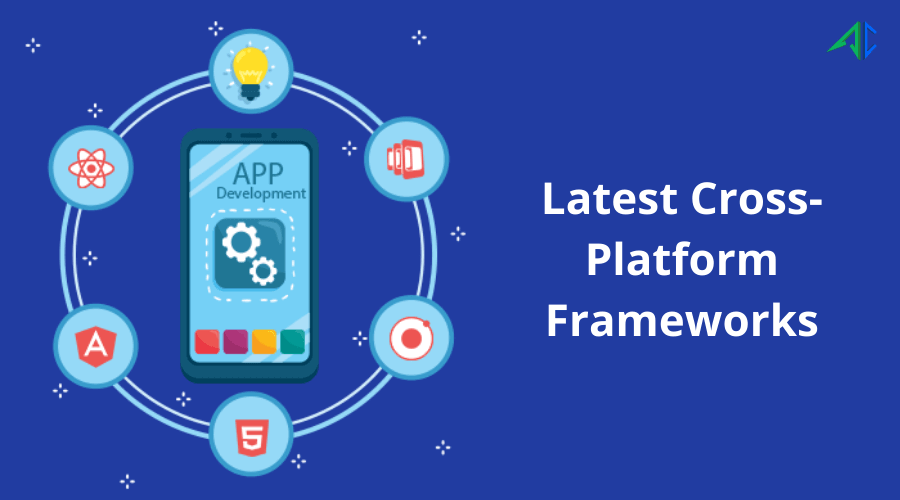Table of Contents
Do you prefer a cross-platform approach? Are you seeking the top cross-platform frameworks to build your hybrid mobile app? This blog discusses the latest cross-platform frameworks for the most reliable hybrid app development!
App development has come a long way over the years. Smartphones and mobile apps have made various significant changes in people’s lives. The constant evolution of technology has made mobile app development a lot easier.
The most significant innovation in mobile technology has been mobile app development frameworks. When we talk about app development frameworks, it mainly comes down to native apps vs hybrid apps. With the advent of cross-platform frameworks for hybrid app development, the demand for mobile app developers has also surged.
What Is a Hybrid App Development?
As the name ‘hybrid’ suggests, hybrid mobile app development is a blend of both native and web applications. Hybrid apps are web apps that have been put in a native app shell.
These applications are popular because they allow developers to write code for mobile apps once and still accommodate multiple platforms. Hybrid app development has gained popularity all over the world, yet many businesses often think, “when should I take a hybrid app development approach?”
Top 5 Reasons to Choose Hybrid App Development
- Native Experience with Simple Backend – Hybrid apps provide the most of what native user experience (UX) offers and the sleek backend structure. The users of the hybrid app experience fluid native feel even if they shift from one device to another.
- Budget-Friendly App Development – Budget is a primary concern for every business looking to develop a robust business mobile app. The hybrid mobile app development is budget-friendly for sure, as it costs half compared to native mobile apps.
- High-Speed Performance – When compared with other mobile development options, hybrid mobile apps are faster than mobile web apps or responsive websites. Hybrid apps epitomize performance and run quickly on all types of device screens.
- Multi-Platform Support – Hybrid applications have no limit to how much they can expand and support almost all platforms if they are popular. However, its performance across different platforms depends on the framework used to build the apps.
- Offline Support – Offline support of any hybrid app could be one of the most rewarding features in today’s time. In hybrid apps, users can store specific data locally due to the device’s API as offline storage.
Top 10 Emerging Cross-Platform Frameworks to Build Sleek Hybrid Mobile Apps
Now that we know many things about hybrid app development, it’s time to take a look at some of the most prominent frameworks that you can use to achieve your desired app goals. Let’s delve deeper and go through all the latest cross-platform frameworks for hybrid app development.
React Native
React Native should always top the list of hybrid app development frameworks. Developed by Facebook, the React Native App Development is the most popular among developers. The primary purpose of this framework is to create native apps over hybrid apps. Developers prefer the React Native framework because it allows them to develop a cross-platform app and grant a native-like experience to the end-users.
React Native is extensively used to create iOS and Android apps with a single JS codebase. App developers who are well-versed in Java and Swift love to work on React Native framework and make innovative mobile applications.
Key features of React Native:
- Supports Node.js
- High-powered, delivered with native code
- Ready to use elements for the faster development
- Use the same codebase between iOS and Android
- Hot deployment without the need of the developer to save changes
- Provides automatic error detection
- Backed by a vast community of developers
- Features live reloading with two different screens
Ionic
Ionic is one of the promising, feature-rich, easy-to-use frameworks for building hybrid mobile applications. This framework is an open-source SDK and based on CSS and reaches its maximum potential when used with Angular JS. Developers highly prefer this framework for cross-platform app development, as it is easy to learn and enjoyable to use.
Ionic has a rich library with front-end building and premier user interface (UI) components that allow developers to build amazing Progressive Web Apps (PWAs). Ionic helps developers achieve UI design aspects like image design and placement, typography, innovative themes, and more.
Key features of Ionic:
- Provides a rich collection of amazing features
- Develops once and apply them across all platforms
- Builds robust apps when used along with AngularJS
- Easy to maintain codes with faster development
- Well-tested programming languages
- Live reloading system and app enabling to preview app
- Provides you with debugging tools
- Backed by a large developer community
PhoneGap
PhoneGap is an open-source, simple, yet powerful mobile application development framework. PhoneGap is best for novice mobile app developers. While talking about top hybrid app development frameworks, you cannot rule out PhoneGap. The knowledge of HTML5, CSS3, and JavaScript provides reliable cross-platform compatibility with just one code for different platforms.
PhoneGap’s best feature is ‘Build,’ a cloud compiler that can compile apps even without any SDKs installed. With PhoneGap, developers can mold a feature-heavy and fully-customized hybrid mobile app.
Key features of PhoneGap:
- Compatible with Windows 7, iOS and Android
- No investments and specific knowledge required
- Quick app-building supported by multiple mobile OS
- Greater access to Native APIs
- Easy to learn, highly flexible
- Compatible with the plugin architecture
Xamarin
Xamarin is known as the hottest framework for building cross-platform hybrid mobile apps with a native look and feel. It is known to abide by the WORA (Write once, Run anytime) concept that allows developers to leverage the same code for different OS, including Windows, Android, iOS, and macOS.
Using C# language for coding, apps built with Xamarin show absolute prowess. C# coding allows Xamarin to use .Net features and leverage native API access for its apps. On Xamarin’s official forum and third-party websites, it has a vast community and substantial support.
Key features of Xamarin:
- Backed by Microsoft, supporting all technical aid
- Over 70% code is reusable between iOS and Android
- Ensures the same level of performance as a native mobile app
- Provides you with platform-specific features to supplement the general codebase
- Simplified testing
Intel XDK
Another framework in the list of top hybrid app development frameworks is Intel XDK, which allows an individual to develop cross-platform app development. Intel XDK simplifies workflow and enables developers to easily design, develop, and deploy apps across multiple websites. Intel XDK can help developers work on tasks that range from development to emulation, debugging or testing.
Key features of Intel XDK:
- New released extend its support to Android, iOS, and Windows
- Offers developer-friendly features and works as a one-stop solution for all development activities
- Synchronization with an increasing number of operational systems
- Its toolkit satisfies all developer needs
Flutter
Flutter is an app SDK for building high-performance, high-fidelity apps for iOS, Android, and web apps from a single codebase. It’s Google’s toolkit for creating visually stunning cross-platform apps. Flutter stands a good chance to outshine the traditional hybrid mobile app development tools in the future.
Also, Flutter sets a go-to choice when you need to quickly craft an aesthetically appealing and interactive MVP. Its flexible design components let developers craft a stunning UI in very less time. To simply put, it’s a power-packed toolkit for hybrid app development.
Key features of Flutter:
- A fast and flexible framework
- Real-time updates with not stopping for changes
- Compatible with multiple operating systems
- Extensive choice of widgets for easy customization
- Open-source technology accessible to all developers
jQuery Mobile
Among all the hybrid app development frameworks, jQuery Mobile takes a different approach in delivering cross-platform mobile apps. It is an HTML based, touch-optimized, JavaScript library used to make responsive websites that are easily accessible on all smartphones.
Besides, jQuery Mobile is a fantastic framework for organizations that believe in BYOD’s ideology (Bring Your Own Device) as it provides its support for various operating systems.
Key features of jQuery Mobile:
- A stable framework to work upon comfortably
- Ensures the screen’s responsiveness with size and different devices
- HTML5 and JavaScript make the development pretty easy
- Convenient menus make apps extremely user-friendly
- Includes add on for creating custom themes
- No additional knowledge is required to master it
Framework 7
Framework 7 is a full-featured HTML framework for creating iOS and Android apps. Framework 7 CLI is a potent tool and the most recommended way to start Framework 7 mobile app development.
It enables to create projects with different variants to choose: Framework: Framework 7 Core, Framework 7 – Vue, Framework 7 – React; Target Platform: web app, PWA or Cordova app; Starter Template: Single Views, Tabs, Split View; Custom Color Theme; Generate required icons and splash screen.
Key features of Framework 7:
- Not dependent on any third-party library even for DOM manipulation
- Can also be used with Angular and React frameworks
- Required knowledge of HTML5, CSS3, and basics of JavaScript
- Supports faster development via a browser
Corona SDK
Corona SDK is an apt choice if you want to add bright and appealing graphics to your apps, which is often the case for the gaming industry. It is a reliable cross-platform mobile app development for enterprises, education, and 2D games that is 4x faster.
With Corona SDK, commercial software providers can easily rely on fast monetization of their apps. It utilizes Lua as a scripting language in real-time testing.
Key features of Corona SDK:
- Developers can instantly see the changed results
- Convenient simulator equipped with necessary features
- Well-thought-out API.
- Detailed guidelines to help you master all the framework’s elements
- Powered by Lua based framework, a light-weight scripting language
Mobile Angular UI
Mobile Angular UI is a good framework choice for anyone using Bootstrap or Angular JS comfortably. It can be considered an extension of the existing Bootstrap 3 without any dependencies of Bootstrap JS libraries or jQuery. Also, there are several UI components like scrollable areas, navbars, switches, overlays, and more.
With the use of Mobile Angular UI, developers can build seamless mobile applications. This framework ensures that users are treated with a smooth, intuitive, and appealing user interface (UI).
Key features of Mobile Angular UI:
- Comes with fastclick.js and overthrow.js for best user experience
- Open-source and available for free
- Offers optional libraries as a bonus
- No dependency on jQuery or any other library
- Makes the app design completely responsive
Winding Up!
With so many worthy framework options, hybrid app development creates a win-win situation over reaching out to the larger audience. We’ve gone through in detail about hybrid mobile apps and the best available cross-platform frameworks for its development. Hopefully, reading this blog will clear all your doubts about hybrid app development frameworks and help you select the right framework among all of the mentioned above.
We would love to hear your comments relating to the post. Got some other thoughts? Drop us words through our contact page.







